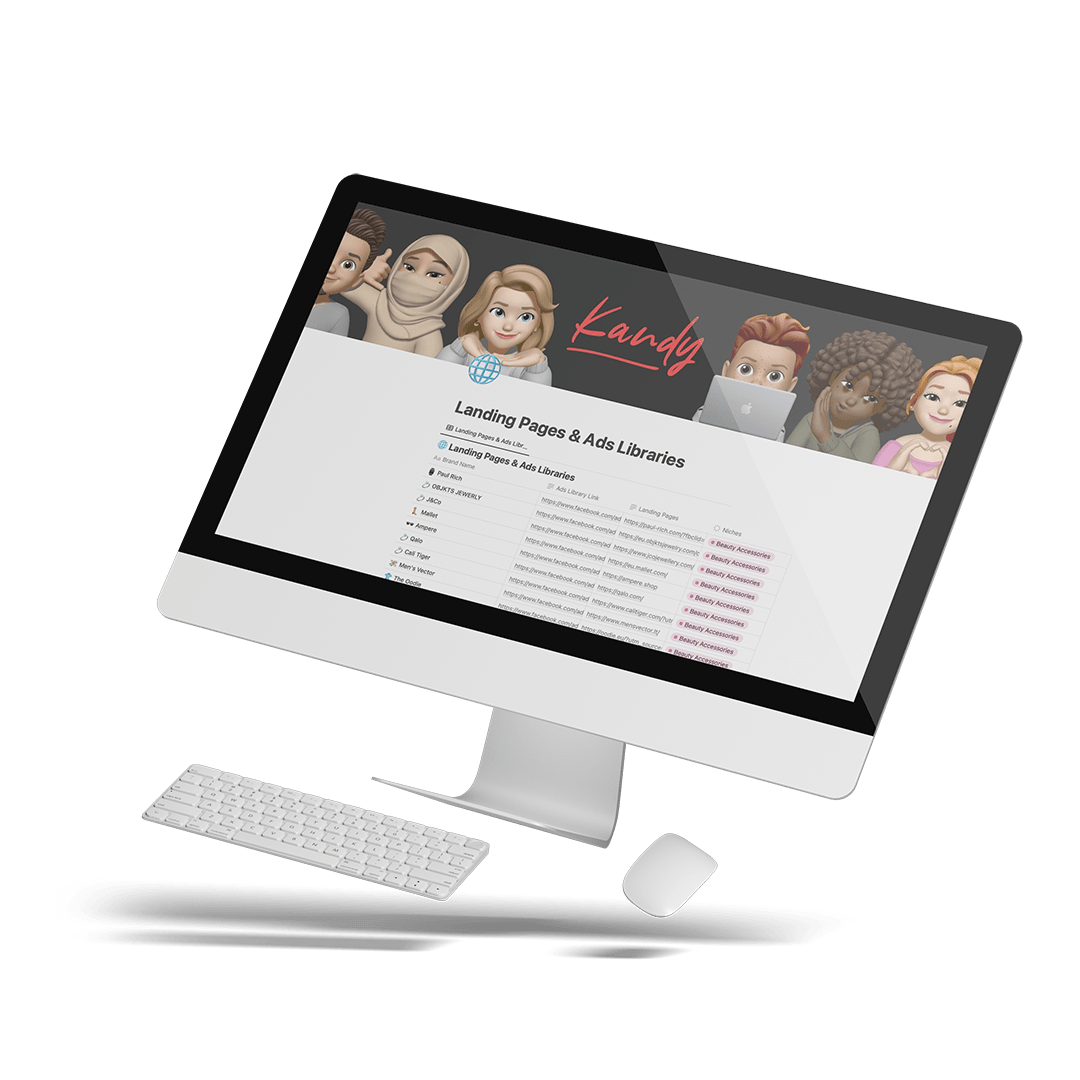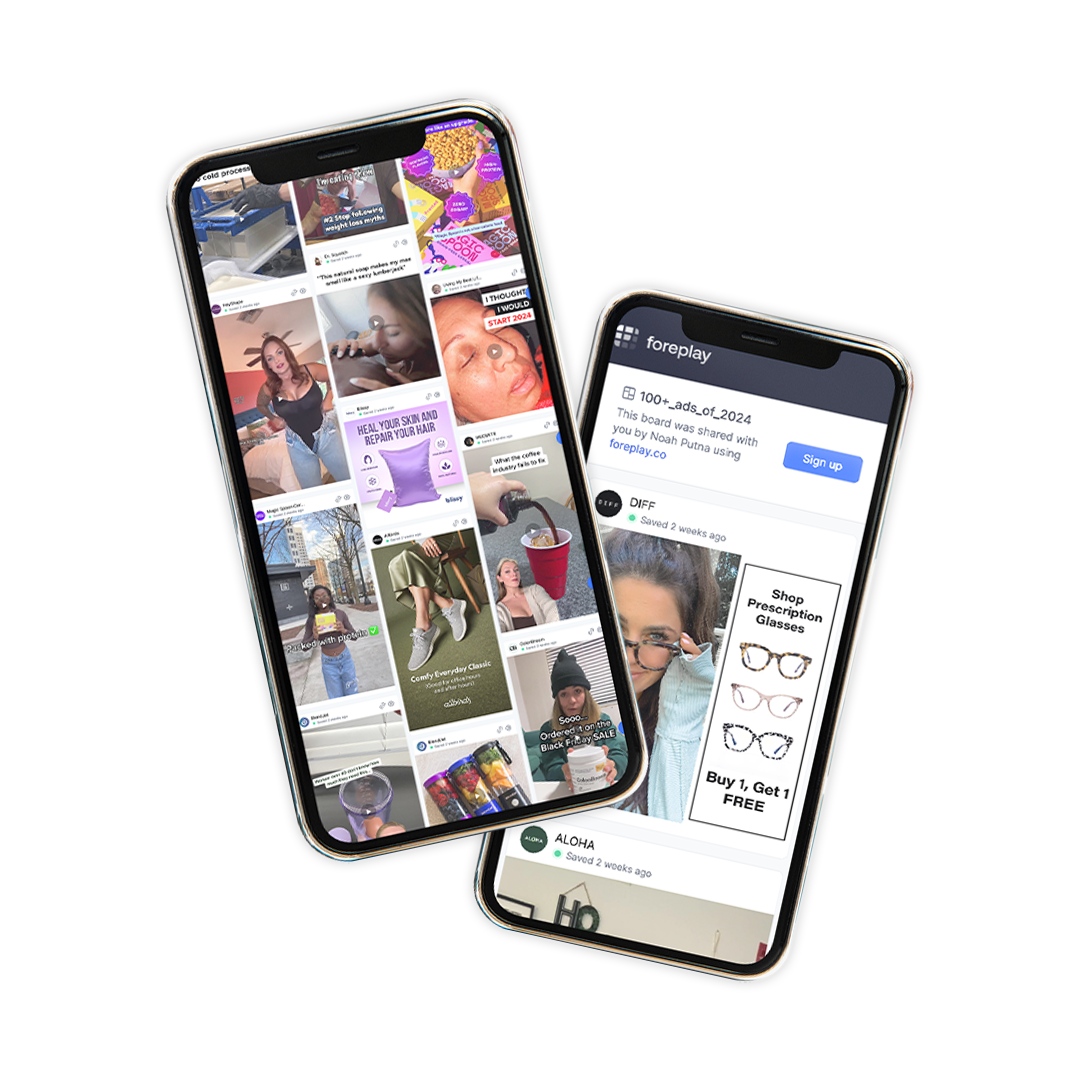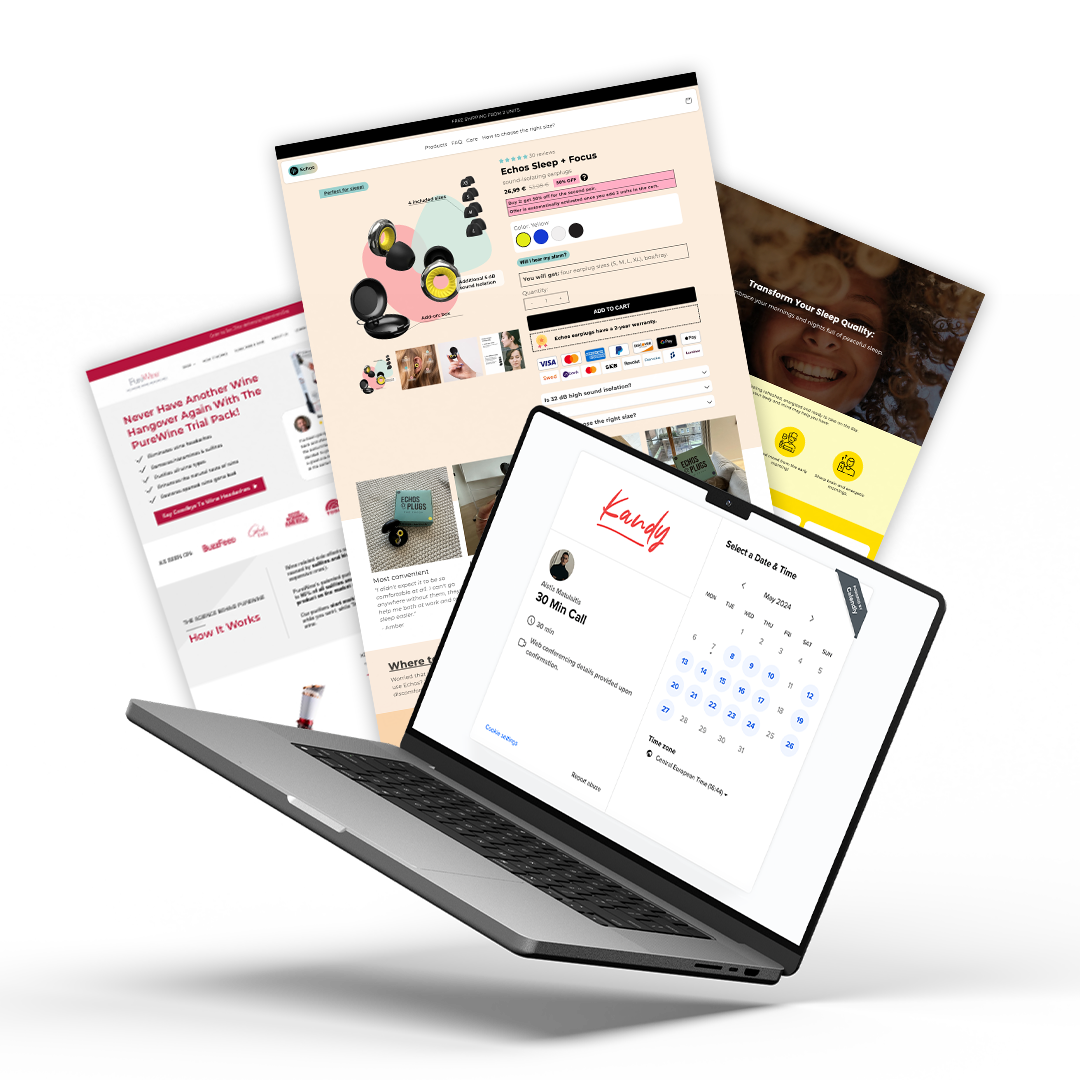Step By Step Process Of How We Scaled Brand from $0 to $1,331,443.79 in Monthly Revenue in 11 months.

Before getting deep into the step-by-step process of how we’ve scaled this brand, let’s see what we’ve achieved within 1 year:

• Scaling DTC eCommerce brand from almost $0 to $3.8M within 1 year.
• Managed to scale the brand from scratch with a 27% NET profit margin (Yearly ROI: 3.1x).
• Increased the AOV by 94% (From 35$ to 68% on average).
• Increased the number of fulfilled monthly units from almost 0 to 70K.
Initial goals / challenges with the client
• Finding the best creative/marketing approach (messaging) which would let us start sustainable growth.
• Increasing our AOV would lead us to bigger profitability.
• Decreasing the CPA (which at the start was around ~$40) in a very competitive market.
• Developing creative angles which would align with the brand owner's vision.
Introduction
How does Kandy scale e-com brands?
It's simple. We reject most of the applicants.
That's not just a marketing trick. Most don't fit our specific criteria. We've failed to scale businesses in the past. That's why now Kandy only works with clients that we know we can bring results.
And then, we run them through our process, which leads them to fast & sustainable growth.
The same thing happened in this case.
They approached us, had a call, analyzed them and we saw that “yeahhh this product has it all”. All main features & attributes to be a successful business were in place. They already had established Amazon business with data, which has let us understand that the product fit in the market is great. This brand had the potential to become the #1 Fidget Toy in the USA eCommerce market.
At first, we had 0 data points for running Facebook ads or any type of traffic to our Shopify website. We didn’t even have any data in Shopify. We had to start from almost 0. But we knew that the product fit is in place and by implementing our consistent & sustainable processes we’ll be able to grow fast and prepare for the Q4, which will happen at the end of the year (obviously: the most important event in eCommerce).
But saying that I believe we can jump into the more in-depth analysis of each quarter.
Q1 | January - March
Stats:
Quarterly Revenue: $193,667.07.
Quarterly Ad Spend: $90,586Quarterly ROI: 2.14x
AOV: $35.06
Conversion Rate: 3.52%Average CPA: $22
Whenever we onboard a new client, especially those which are in the very early stages of their journey in Shopify eCommerce, we kick off with MMM Triangle.
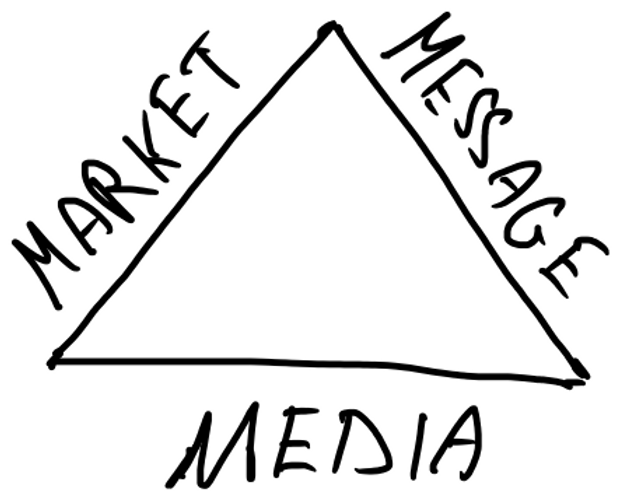
MMM Triangle contains 3 main variables for building a scalable funnel. It helps us to start building a strategy around the things that actually mean the most in growing.
Triangle contains:
Message: A truly compelling, preferably irresistible, marketing message or in other words: Offer.
Market: High-profitability target marketing that identifies only those most like to respond. Or it can be called -> Advertising.
Media: The most appropriate, effective combination of media used to deliver your message to your market., also known as Marketing/Creatives.
...and yes, there are a lot of more narrow things that lead you to sustainable growth, but if you look at every business from a bird’s eye view, you will be able to that these 3 things, are the MOST important in the game of marketing, eCommerce or any other online business.
Since they didn’t have any type of data, we’ve started to execute with Market & Media.
Within the first week, we built a website without any offers, filmed & edited a batch of 25 video creatives, wrote 10x copies, set up 2 most important email flows (welcome & abandoned cart) and we launched our first Facebook campaigns.
The reason why we executed fast was super simple -> to get that first piece of data, from which we would be able to start crunching those numbers and making important data-driven decisions.
After the first 2 weeks, we saw, that this account has a lot of positive potential.
The Interest in the product was high -> High CTRs.
Creatives & Product creates a high emotional state for the target audience -> High Engagement Rates.
The Ad Account was instantly very scalable vertically, which lead us to believe, that the audience to play with is VERY BROAD.
The initial Conversion Rate of the website was about average.
Etc etc.
…and know we had a much clearer vision of how we should proceed further that year.
Q2 | April - June
Stats:
Quarterly Revenue: $302,349.29.
Quarterly Ad Spend: $143,167.41
Quarterly ROI: 2.12x
AOV: $51.05
Conversion Rate: 3.92%Average CPA: $24
During March we were already entering the $100K a month revenue line, but…
We stopped running ads.
And it wasn’t for bad intentions, actually, it was for a really good reason that most businesses usually fail to capture.
The reason was super plain - in order for us to start scaling hard vertically, there wasn’t a proper fulfillment process developed in place.
Many entrepreneurs tend to miss this part, which in the long-term game is crucial.
And by saying crucial, I meant it.
Good thing is that we’ve already experienced several times the fast growth of eCommerce businesses and we knew that this has to be resolved as soon as you see that you will have a very good ride in the long-term game, especially when we have Q4 coming 6 months.
Having reliable fulfillment and warehouse solution gives you:
Ability to scale the volume of orders fast, without any cracks which would lead you to have unsatisfied customers.
Ability to have higher profit margins -> cut pick & packing and shipping costs.
Faster delivery -> more satisfied customers.
Etc etc.
These types of offers are the most common ones in the game. They are saturated. They usually don’t make sense. They cut your profits a lot.
Yes, most probably you will see a bit better Conversion rate, BUT you won’t see an AOV increasing together or Conversion Rate growing almost 2 times. To say it simpler -> you won’t scale your brand to 7 figures with it.
Usually, an offer is known as a discount.
Well, it is not.
Offer is 30% of your business.
Offer needs to resonate with the problem that you are solving. It has to create the desire.
So let’s talk about what we did.
Before Offer:
Our Retail Price was $24.
That’s it. With an AOV of $24 it is almost impossible to scale the brand in a very competitive market (demos: 45+ women mainly). You will be eaten up by the CPMs and CPCs. It is even quite hard, close to impossible to go on breakeven.
Due to that the thought process behind the offer building:
We are one product store, but with multiple variants (different unique designs)
Our product is stackable. What does that mean? It is such a fidget toy with which you are able to have to collect & connect them. The more you have them, the bigger things you can build. This means that we need to reward customers for buying more units -> Quantity Discounts.
When people have bigger cart values, they always want to be rewarded with Free Shipping. If they select to buy more = they want no more friction points in the buying process. That’s why we implemented Free shipping if you buy 2 or more units.
But we want to create a desire to buy even more than 2 units. This leads us to create additional incentives for those who are willing to buy 3 or 4 units. We implemented a “free secret toy”. Rewarding them with a free toy creates even more desire. It means that the customer (in our case mainly parents and grandparents) will increase the outcome they will get. The outcome in our situation is the happiness of the beloved ones (kids/friends). Additional toys = More joy. More joy = More outcome. Well, you get the point.
So what did the final offer look like?
Buying 1 unit - $24 per unit.
Buying 2 units - $24 per unit + free shipping.
Buying 3 units - $23 per unit + free shipping + a free secret toy.
Buying 4 units - $22 per unit + free shipping + a free secret toy.
And now we went to testing.
There is one secret that I want to tell you.
No-brainer offers are really simple.
If your offer is good - you will see the results instantly. You don’t need to wait for 7, 14, or even 30 days for data to gather. No. No-brainer offer = instant reaction from the audience.
What we’ve achieved with this offer after implementation?
Stats after the launch:
AOV: $59 (68% increase).
Conversion Rate went from 3.09% to 4.34% (40% increase).
Monthly Revenue went from $61,185.18 to $206,884.73 (255% increase) (May vs June).
Good offers are responsible not only for AOV increases but also for the Conversion Rate. I tend to hear eCommerce markers talk a lot about how with high-level CRO A/B tests you will be able to increase the conversion rate by a high %. But what they usually miss is that the OFFER is mainly responsible for that. After you find your no-brainer offer, then you can start focusing on improving the user experience on your website. But not the other way around it.
And that’s exactly what we started to do in Q3 -> rapid vertical & horizontal scaling. More about it in the next chapter.
Q3 | July - September
Stats:
Quarterly Revenue: $673,155.09.
Quarterly Ad Spend: $236,834.78Quarterly ROI: 2.84x
AOV: $58.10
Conversion Rate: 4.88%
Average CPA: $19,23
Entering Q3 we had everything:
Message / Offer.
Market / Advertising.
Media / Creatives.
We were set to start scaling rapidly.
That’s exactly what we did.
Rapid Vertical Scaling -> testing at least 5 new creatives every single day.
5 creatives a day = 150 creative units a month. Sounds like a lot, but the fact is that this is what we did. Otherwise, we wouldn’t have made it.
Because without it, you can lose momentum real quick and you will go there where you started.
At that time we allocated our budget 70/30.
70% of the daily ad spend -> Scaling
30% of the daily ad spend -> Testing.
Only by this allocation, we were able to test & learn scale, test & learn scale.
Rinse & Repeat.
Of course, you cannot test creatives blindly.
When I say test & learn, I mean that with every batch of creatives, you analyze data to the bits of it and then learn from it -> which leads you to create more and more data-driven creatives with every new batch you prepare. At the same time, you lower your chance of losing money on testing campaigns and increasing the ROI and CPA gradually.
This strategy led us to find our winning creative angle.I’d like to call this angle -> “Extreme Product Demonstration” angle.
Actually, it was so good, that we were even able to make it as a template and use implement it with our other clients.
So what does this “Extreme Product Demonstration” angle look like?

At first glance, it looks very simple.
The reality is that it is elementary. But it consists of the most essential principles of marketing.
So let’s dive deeper:
Hook (3-5 seconds) -> As you most probably know one of the most important parts of any Facebook Video Ad. Within the first 3 seconds, you have to catch the attention of the viewer so he could enter the next part of the video, where the unintentional selling process begins.
Extreme Product Demonstration (30-45 seconds) -> This is where the magic happens. This angle of course does not apply to ALL the products. But, the vast majority of products have that extreme, unique way of demonstration, which is: very engaging, very unusual, it starts to create desire, it builds up the emotional scale of the potential customer. In this case, simplicity usually wins. You should rather focus on the demonstration, not on how that demonstration is being filmed. Almost all of the winning videos for us were shot with iPhone and tripod, so you get the point. Usually, these videos are faceless, and they are filmed from POV. The product HAS to be at the center of attention. Besides the demonstration, we found that you should invest quite a bit of time in developing a VOICEOVER, where you explain what that product is, what it does, how does it solve the problem, etc. Of course, together with the voiceover, subtitles are a MUST, for those who are watching the video without sound. And lastly, CTA.
CTA (3-5 seconds) -> This part is not a mandatory part. Usually, those people who make a purchase click on an ad in around the 25th seconds. But, to maximize the conversion from an ad, I would recommend it. CTA usually includes an offer, which leads them to go to the landing page.
Are creatives the main thing that you should focus on when you start rapidly scaling?
No.
Let’s talk about CRO.
Higher Traffic Volume = The Start of A/B testing season.
As I mentioned in the earlier chapters, A/B testing is crucial, but usually, it is started at the wrong time. Wrong timing is when you don’t have a no-brainer offer. But since we do...
We started planning.
There are A LOT OF things you can test on your landing page. Such as copy, first fold, second fold, CTA buttons, button colors, badgers, website structure, urgency timers, scarcity, type of carts, straight to checkout or straight to cart, product images, pricing and many many more.
But when it comes to maximization of your results in a short period of time, the key thing in CRO is prioritization.
How does prioritization usually work?
Well, you start by writing off a bunch of different ideas. You analyze every bit of your landing page and try to encounter parts that could create friction for website visitors. After you have a full list of ideas, you start to estimate which ideas, could bring you the biggest improvements. Usually, the biggest improvements are in Hero Fold & Product Selector.
Why?
Hero Fold -> this is the first thing that visitor sees when they come to the landing page. This very first fold could determine a person’s following action. Your first fold has to create the desire for your product. Otherwise, if the first impression is weak, usually you would experience high bounce rates.
Product Selector -> this one is crucial as well. Within this fold, people have to all the necessary information about the product and buying process. Visitors hate to waste their energy and time scrolling through the website and gathering needed information to make the last decision. They have the very little attention span and you have to make their shopping experience almost effortless.
In our case -> we’ve started with the A/B test of the Product Selector. We have one product, with 12 different designs (variants). So we had to make such a product selector with which they would be able: to understand how the offer work, select different quantities for different designs, see the differences between designs, see how much they save if the quantity is rising, and what benefits come with buying more and more. See? A lot of things to put in one place. But we knew that if we won’t figure out it, we will be stuck.
So we prepared first prototype of the product selector.
It looked drastically different than the old one but based on the data we took calculated risks and launched the A/B test.
What were the results?
Conversion rate (Before): 4.32%
Conversion rate (After): 5.21% (20% improvement).
20% may sound not so much.
But in the game of CRO, it is huge.
It helped us to lower our CPA (Cost per Acquisition) from $25 to $20. Decrease of 25%. That’s huge. Our ROI went from ~2.5x to ~3x.
This was a massive win for our CRO.
Among this test, during the Q3 we managed to do 8 other smaller tests, which lead us to have really stable Conversion Rate before entering the Q4. Nobody wants to enter Q4 with a broken landing page, haha.
But talking about increasing ROI, not only the A/B test helped it.
Every month we tend to dive deep into the profit reports of the previous month. And in the end of July, we figured, that going forward our focus needs to be diversified a bit.
Switching from Revenue maximization to profit-driven vertical scaling (lowering CPA, increasing AOV, increasing ROAS).
Despite the fact that we were doing successful tests in the Creatives and CRO area, we understood, that before entering the Q4 we need to learn more about the way we do the advertising (Facebook Ads). By learning, I mean investigating every detail of an ads manager.
The main issue appeared, that the ads account structure didn’t give us a lot of room for scale. We identified, that every time we put a bit more aggressiveness into scaling our CPA increases by a lot. Which would mean, that by doing a rapid vertical scaling, we would start losing the ROI.
Of course, it depends on numbers, you can start losing the ROI, but if the Revenue Volume is increasing faster then in the end you will end up with more profits.
But since there was a lot of space for improvements, we’ve dedicated the whole month of September specifically to testing different setups, using different optimization methods and etc.
And viola.
Cost Cap Campaigns.
This account just reacted super well to transferring all the campaigns from Lowest Cost to Cost Cap campaigns.
Our winnings were:
Manage to reduce the CPA by 20%.
CTRs increased.
Aggressive budget scaling wouldn’t affect their performance.
It looked like the Cost Cap campaigns are just a perfect fit for this ad account.
At the end of September, we managed to grow 58% in comparison with August.
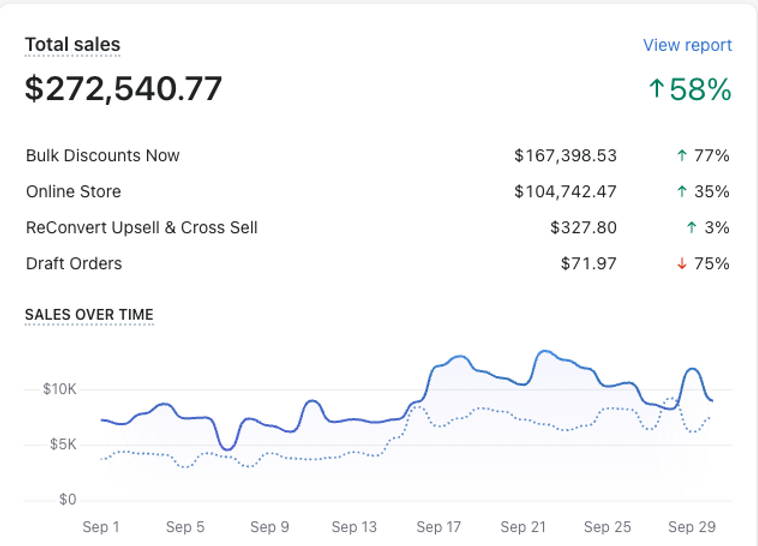
Usually, we look to Q3 as a preparation period for Q4. All the tests & learnings are dedicated to the best performance for Q4.
Let’s jump straight into it.
Q4 | October - December
Stats:
Quarterly Revenue: $2,610,219.24.
Quarterly Ad Spend: $730,597.93Quarterly ROI: 3.57x
AOV: $58.10
Conversion Rate: 5.11%
Average CPA: $16,21

This is what we generated during Q4.
Forecasts were over-delivered 2x. 2 times could look like that is not much, but when you talk about millions, then 2x is huge.
We were almost out of stock 2 times. But that's where all the effort that was put into hiring proper fulfillment house paid off.
Anyways.
I won’t get deep into step-by-step BFCM/Q4 strategy, because for this I could write another couple of articles, but I will outline the main needle movers.
3 main things that brought 288% growth over the quarter were:
Starting early.
Securing / Buying Leads ($$$) for BFCM
Ultimate Email Strategy for BFCM.
Since this product is perfect for gifting, we decided to start increasing the budgets very early (around mid-October).
This gave us a huge advantage over the competition because we were starting to build up our position in the auction of Facebook Ads quicker and we were able to generate more eyeballs (attention) for a better price (CPMs below market average).
We took advantage of that and managed to grow 155% over October in comparison to September.
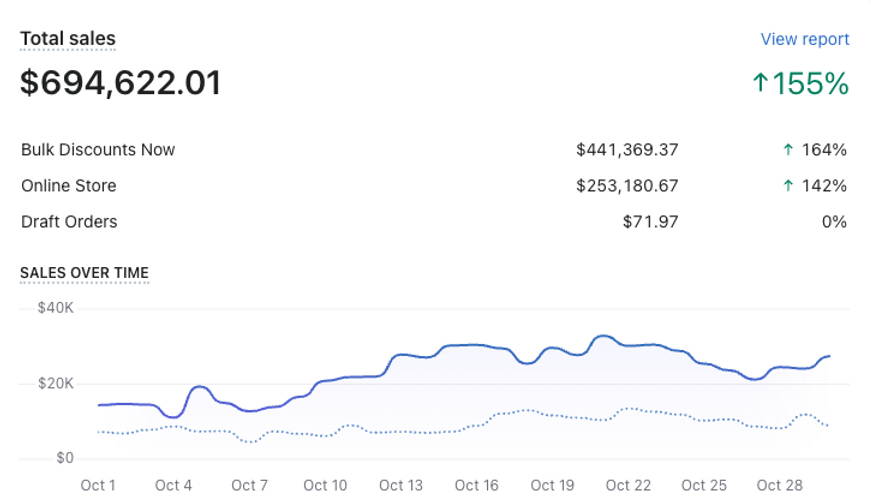
But entering November we knew that CPMs will start to increase together with our CPC. Due to that, during October it is CRUCIAL to set up a proper Opt-in system for your landing pages.
You have to try to collect as many emails as possible before BFCM because during the actual BFCM -> all those leads will transform into the $$$.
Getting back to the Opt-In. I’ve developed a SPECIAL EMAIL OPT-IN FORMULA, which gave us 16.71% opt-in rates.
Imagine, for every 100 visitors, you capture 16 emails.
Now think bigger.
When you have 10’000 daily visitors and get 1600 emails daily imagine how big of an impact you can make on your revenue during the BFCM.
By doing an aggressive opt-in for 21 days before BFCM, you could collect additional 33k+ emails that will convert to that big buck ($$$).
But that wouldn’t be possible without a SPECIAL EMAIL OPT-IN FORMULA. For this, I made a special Loom run-through so you could get an idea and implement it in your business asap.
Collecting leads it’s not the finish line. With all those collected leads now you have to execute on your email strategy.
BFCM Email Strategy is another huge topic, but I will tell one specific thing that generated almost 50% of all BFCM email revenue.
And it is a VIP BFCM Campaign.
VIP campaign strategy is a needle-mover.
How does it look?
At the beginning of November, you start segmenting your VIP List.
Segmentation starts by sending frequent campaigns by which you will be hyping people up about being a VIP and being rewarded by getting a VIP BFCM Offer
You must prepare actually the BEST BFCM Offer for them. I recommend it to be even better than the Offer you will be giving during Black Friday itself.
You need to dedicate one weekend before BFCM weekend for VIP List campaigns.
And boom. You blast them with high-frequency emails during that weekend.
Make sure you make them feel special by communicating & rewarding them.
Also, you got to remember, that a huge proportion of the VIP list will include your best customers. So do not undercut them. If you are giving the best offer -> give it, no games here.
VIP Campaigns strategy led us not only to High Revenue Days but also HIGH-PROFIT DAYS. (Attaching the screenshot below).

Also, we needed to make sure that our list is not dried up from high-frequency emails, so we were not super active during October. I recommend securing all that attention on your list for the end of November because I can guarantee that they will be way more active. Everybody (especially in the USA) waits for BFCM. They are aware of it.
Despite all things mentioned above, we were just really into buying media and making data-driven decisions on a day-to-day basis, even sometimes hour-to-hour basis.
Allocating budgets to particular campaigns is crucial. No guesswork.
December = Q5.
This month shouldn’t be left out of your strategy. Usually, the first 3 weeks of December can be at some points even more intense than November.
You got to make sure that stock levels are prepared for the last month of the year as well.
Because if you sell out during November, you could leave a lot of money on the table.
Due to fact, forecasting your Q4 during the summer can determine your December performance.
One quick tip for December -> Set the exact date for guaranteed delivery before Christmas.
It excludes all unnecessary friction from last-minute shoppers. And it gives you clear room for scale.Example: We even had our most profitable day of the year in December. This date was a deadline for guaranteed shipping and people were just crazy to act on it.
Don’t leave that cash on the table.
